|
|
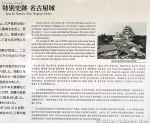
Nagoya Castle is Nagoya's most visible attraction and symbol of the city. It is most closely associated with the Tokugawa after Ieyasu decided to rebuild it in the early 1600s. Twenty daimyo lords from Western Japan were ordered to build the castle including Kato Kiyomasa who built Kumamoto Castle. It was the base of the Tokugawa's Owari branch. The main castle tower was paired with a smaller tower and the Hommaru Palace and Ninomaru Palace were built nearby.
|
|
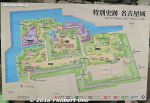
Sadly, the original buildings were destroyed by World War II firebombings by the US. The main castle tower was reconstructed with ferro-concrete in 1959. And now, since 2009, they are reconstructing the Hommaru Palace. They are using traditional materials and methods of construction.
|
|

Nagoyajo subway station on the Meijo subway line. Nagoya Castle is near Nagoyajo Station (used to be named "Shiyakusho") which is also near Nagoya's city hall. This station exit has a castle motif.
|
|

Near the station is Nagoya City Hall (Shiyakusho) which also sports a castle motif.
|
|

As you walk toward the castle entrance, you see this Sotobori outer moat.
|
|

Bridge across the Sotobori moat to East Gate 東門
|
|

To East Gate
|
|

When I revisited in July 2016, the Nagoya Basho sumo tournament was underway.
|
|

The drum tower on the left is for the sumo tournament.
|
|

Aichi Prefectural Gymnasium is within the castle grounds. It is also the venue for the Nagoya sumo tournament held in July. 愛知県体育館Sumo wrestlers were coming and going. These are low-ranking wrestlers who walk and take the subway like the rest of us. The high-ranking wrestlers travel by taxi or their own car.
|
|

East Gate ticket gate
|
|

East Gate ticket gate. Nagoya Castle admission is ¥500 for adults. Open 9 am to 4:30 pm. Closed Dec. 29–Jan. 1.
|
|

After I paid the admission and went in, there was a rack of pamphlets about the castle in various languages. As usual, I picked up the English and Japanese versions. Then this Japanese lady suddenly came up to me and said in English, "Hello, are you going to visit the castle?" I said, "Yes." She offered to be my volunteer guide. I told her that I could understand Japanese, but would be glad to have a guide anyway. So she guided me through the new palace and the castle tower for about 90 min. She serves as a volunteer guide once a week. I have to give my thumbs up to her and her volunteer group for being so hospitable to foreign visitors.
|
|

This American guy named Chris O'Neill is a member of Aichi's ninja troupe named "Tokugawa Ieyasu and Hattori Hanzo Ninja Squad" to promote tourism in the prefecture. They perform at Nagoya Castle and elsewhere. He was selected from 200 applicants from 40 countries. I ran into him when while exiting the castle. Too bad I didn't catch their show. He was very friendly. He's very good at doing these ninja stunts.
I have to compliment Aichi for forming such a PR troupe and including an amusing foreigner to boot. I'm sure they are getting their money's worth in terms of goodwill and good impressions on tourists.
|
|

Although Nagoya Castle is impressive, it never had the pizazz or aura of being anything special compared to other major castles (especially the National Treasures) in Japan.Mainly because the main castle tower is a 1950s ferro-concrete reconstruction of the original National Treasure that sadly got destroyed by WWII fire bombings. It has been a relatively humdrum castle, and people in Nagoya knew it.
|
|

Southeast corner turret (Important Cultural Property)東南隅櫓
|
|

Southeast corner turret (Important Cultural Property). Also called the Tatsumi Yagura turret. It has bay windows to drop stones. 辰巳櫓 東南隅櫓
|
|

Southeast corner turret東南隅櫓
|
|

This humdrum-ness of Nagoya Castle is about to disappear as it is on track to regain its former glory as they reconstruct the original Honmaru Palace next to the main castle tower.
|
|

Rocks are temporarily stored here from another part of the castle wall being repaired.
|
|
|
|

Kiyomasa depicted as the rock hauling director. When building the castle, many men had to push and pull large rocks into place. On top of a large boulder, a man would shout and direct the men to move.
|
|

Kiyomasa depicted as the rock hauling director. When building the castle, many men had to push and pull large rocks into place. On top of a large boulder, a man would shout and direct the men to move.
|
|

Sotobori moat 外堀
|
|

Uchibori moat
|
|

Uchibori moat
|
|

Omote Ni-no-mon Gate (Important Cultural Asset). Entrance where most people enter the castle's center. 表二之門
|
|

Kiyomasa's stone
|
|

Stone wall corner
|
|
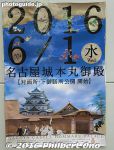
The palace is where the castle lord lived and worked, while the castle tower was usually just a storehouse and visual symbol of power and authority.
|
|

This photo was taken in July 2016 showing the main entrance (called "Kuruma Yose" 車寄 reserved for the castle lord and other VIPs) of the magnificent reconstructed Honmaru Goten Palace.Above the entrance is an architectural feature called "karahafu" which is a hump-shaped gable commonly seen on important buildings such as castles, temples, and palaces.
|
|

This is Nagoya Castle when I visited in 2006. In the foreground, you can see the stone foundations of the Honmaru Palace still remaining.
|
|

Palace foundation stones. The palace, destroyed during WWII, served only as luxury lodging for the shogun passing through. The architecture was similar to the palace at Nijo Castle.
|
|

What the Hommaru Palace will look like when completed.
|
|

Photo of the original Hommaru Palace before it was destroyed during World War II.
|
|

Ironically, the castle lord lived in the Honmaru Palace for only a short period before moving to the much larger Ninomaru Palace nearby. No plans to reconstruct the Ninomaru Palace.
|
|

Inside the main entrance called "Kuruma Yose" 車寄 reserved for the castle lord and other VIPs.
|
|

Nagoya's new Hommaru Palace is right next to the tenshukaku main castle tower.
|
|

This photo from 2006 shows an empty lot next to the main castle tower.
|
|

Reconstructed in 1959 in ferro-concrete, Nagoya Castle's main tenshu tower has closed on May 6, 2018 to start its monumental reconstruction. 天守閣This main tower used to house a museum. The top floor had a lookout deck with fine views.
|
|

Closeup of castle tower, with shachihoko on top. Nagoya Castle is famous for its golden pair of shachihoko roof ornaments. During the Aichi Expo in 2005, they were taken down for public display. 天守閣
|
|
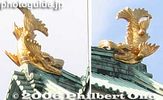
Symbol of Nagoya, golden shachihoko. Killer whale or fish with a tiger's head.First believed to protect the building from disasters, but later served as the symbol of the castle lord's authority. The original pair was destroyed along with the castle tower during WWII, but they were remade in 1959 along with the castle tower. Later, they were recoated with gold. They gleam very well on sunny days. The male fish is on the right (north), and female (south) on the left.
|
|

This palace was modeled after the Nijo Castle palace in Kyoto, so it looks similar on a smaller scale. Both Nijo Castle and Nagoya Castle were connected to the Tokugawa shoguns.
|
|
|

Elegant roof line
|
|
|

The reconstructed palace uses the original foundation stones in their original place. Can't get more authentic than this.
|
|
|

Beam fixture
|
|

Side entrance to the reconstructed palace. We can enter and tour the completed portion of the palace here. Have to take off your shoes. Photography is permitted, but flash is prohibited.
|
|

When you first enter the Hommaru Palace, you're in a room called the Nakanokuchibeya (中之口部屋). Take off your footwear and backpacks, bags, etc., are required to be stored.
|
|

Shoe lockers where you can store your footwear.
|
|

Corridor of the palace, made of fragrant hinoki cypress.
|
|
|
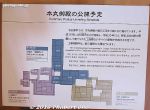
About half the palace has been completed and opened to the public.
|
|

The first section we see is the Genkan entrance hall consisting of two rooms next to the Kuruma Yose VIP entrance. This is the Ninoma room. 二之間
|
|

All the paintings are painstakingly hand-painted replicas of the original art. Nagoya Castle's Hommaru Palace.They have excellent records and photos of the original palace (floor plans, etc.) so they are working to reconstruct the palace as close to the original as possible. Magnificent.
|
|

Genkan entrance hall’s Ninoma room. The original painters were from the renown Kano school of painting. 28 tatami mats. 二之間
|
|

Paintings of mythical tigers and leopards. They are reproducing the artwork as faithfully as possible. An absolutely magnificent job. Really painstaking though, as they trace over original paintings. This palace is slated to be completed in 2018, after 9 years of work. The original palace took only 3 years to complete.
|
|
|

Next to the Ninoma room is the Genkan entrance hall’s Ichinoma room that includes an alcove. 18 tatami mats. 一之間
|
|
|
|
|

Leopard at Nagoya Castle's Hommaru Palace.
|
|

Next section is the Omote Shoin (表書院) Main Hall consisting of five rooms. This is the San-no-Ma 三之間.
|
|

Omote Shoin (表書院) Main Hall's San-no-Ma Room 三之間.
|
|

Omote Shoin (表書院) Main Hall's San-no-Ma Room 三之間.
|
|

Even the design of the tatami mats's edges are matched seamlessly.
|
|

Corridor. All hinoki cypress wood, giving a pleasant aroma.
|
|
|

Omote Shoin (表書院) Main Hall's Ni-no-Ma Room 二之間.
|
|

Omote Shoin (表書院) Main Hall's Ni-no-Ma Room 二之間.
|
|

Sliding door painting in the Omote Shoin (表書院) Main Hall's Ichi-no-Ma Room 一之間.
|
|

Sliding door painting in the Omote Shoin (表書院) Main Hall's Ichi-no-Ma Room 一之間. Nagoya Castle's Hommaru Palace.
|
|

Sliding door lock.
|
|

Sliding door painting in the Omote Shoin (表書院) Main Hall's Ichi-no-Ma Room 一之間. The main hall features paintings of flowers and birds.
|
|

Sliding door painting in the Omote Shoin (表書院) Main Hall's Ichi-no-Ma Room 一之間.
|
|

Sliding door painting of birds in the Omote Shoin (表書院) Main Hall's Ichi-no-Ma Room 一之間.
|
|

The Omote Shoin (表書院) Main Hall's Jodan-no-Ma Room which is reserved for daimyo of Nagoya Castle. 上段之間.
|
|

The Omote Shoin (表書院) Main Hall's Jodan-no-Ma Room which is reserved for daimyo. 上段之間.
|
|
|
|

This section is the Taimenjo (対面所) Reception Hall consisting of four rooms.
|
|

The Taimenjo (対面所) Reception Hall is most impressive.
|
|
|

Special latticed ceiling of the Taimenjo (対面所) Reception Hall's Jodan-no-Ma room reserved for the daimyo lord.
|
|

Paintings show scenes from Wakayama.
|
|

The Taimenjo (対面所) Reception Hall.
|
|
|

Very intricate overhead transom made of wood.
|
|

The Taimenjo (対面所) Reception Hall
|
|
|
|
|

Inner courtyard
|
|
|
|
|
|

Another room of the Taimenjo (対面所) Reception Hall. 納戸一之間
|
|
|
|
|

Another room of the Taimenjo (対面所) Reception Hall. 納戸二之間
|
|
|

Preparation room (Shimo Gozensho) to serve the Reception Hall. 下御膳所
|
|
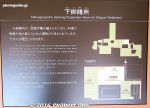
About the Preparation room (Shimo Gozensho) to serve the Reception Hall. 下御膳所
|
|

List of donors for building the Hommaru Palace.
|
|

Donations are welcome.
|
|
|

Thin pieces of wood are stacked on the roof.
|
|
|

Love the fine roof lines.
|
|

Some of the rocks on the stone walls are engraved with the crest of samurai clans that provided the stones and helped to build Nagoya Castle.
|
|
|
|
|
|
|
|
|

Nagoya Castle's main castle tower is paired with and connected to a lesser tower on the left. It is closed to the public and will be dismantled from fall 2019 for its grand reconstruction with wood to be completed in Dec. 2022.
|
|

Picture taken in 2006. 天守閣
|
|
|
|
|
|
|
|

Entrance to the main castle tower when it was still open. Nagoya Castle's main tower closed on May 6, 2018 to be dismantled (and reconstructed). Interior photos were taken when it ws still open.
|
|

Elevator for wheelchairs.
|
|
|
|

Entrance to the main castle tower.
|
|
|

Entrance hall
|
|
|
|
|
|
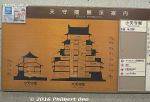
Museum inside Nagoya Castle's main tower had seven floors with exhibits. There was an elevator inside. The smaller tower had nothing except the door and entrance hall.Nagoya Castle's main tower closed on May 6, 2018 to be dismantled (and reconstructed).
|
|
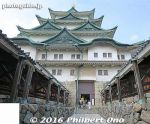
Corridor between the smaller tower and main tower.
|
|

Triangular chidorihafu roof gables on Nagoya Castle.
|
|

Inside castle towerThe castle tower is a history museum.
|
|

Replica of the castle's famous roof ornament, a golden carp.
|
|
|
|
|
|

The 7th floor was the top floor of Nagoya Castle being an enclosed lookout deck.
|
|

Top floor's lookout deck. The top floor only has windows and no balcony.
|
|
|
|

This photo was taken in 2006, showing an empty lot where the Hommaru Goten Palace is being reconstructed now.
|
|

Today, you can see the Hommaru Goten Palace being reconstructed.
|
|

Hommaru Goten Palace being reconstructed.
|
|

Site of palace building before it was rebuilt. Only foundation stones remained.
|
|

Aichi Prefectural Gymnasium where the sumo tournament is held in July.
|
|
|
|

Southwest corner turret. Also called the Hitsujisaru Turret.
|
|
|
|
|

Nagoya Station's twin towers in the distance.
|
|

Names of the castle lords.
|
|

Gift shop on top floor
|
|
|

Spiral staircase in the middle of the tower. There's an elevator too.
|
|

Exhibition rooms on the lower floors.
|
|

Oda Nobunaga
|
|
|
|
|

On the 5th floor was an interactive exhibit showing how they hauled large stones to build the castle. You can pull the rope too.
|
|
|

On the 5th floor was a model of shachihoko that you could touch and sit on for pictures.Nagoya Castle's main tower closed on May 6, 2018 to be dismantled (and reconstructed).
|
|
|
|
|
|
|
|
|
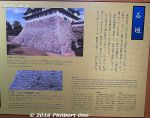
About Nagoya Castle's stone walls.
|
|

One floor recreates an Edo-Era street.
|
|
|
|
|
|

Palanquin for ladies
|
|

Palanquin for ladies
|
|
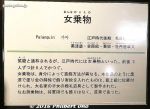
About the Palanquin for ladies
|
|
|

Newly painted sliding doors for the Hommaru Palace.
|
|
|
|
|
|

Swords
|
|
|

Aftermath of the war. Main castle tower gone.
|
|

The 3rd floor has this scale model of Nagoya Castle town.
|
|

Scale model of Nagoya Castle town.
|
|

Scale model of Hommaru Goten palace and main tower.
|
|
|
|
|

Scale model of Hommaru Goten palace.
|
|
|

Corridor to entrance hall in the smaller tower.
|
|

Way out
|
|
|
|
|
|

Fumeimon Gate
|
|
|
|
|
|
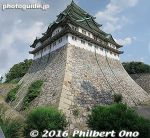
Rear view of Nagoya Castle's main tower (tenshu or tenshukaku in Japanese, sometimes called donjon in English).
|
|

Behind the castle tower is this large woodshop where they cut and shape the wood for the palace.
|
|

You can take one piece of scrap wood for free.
|
|

Wood shop is open to the public viewing 9 am to 4 pm. Closed on Sun.
|
|

They have windows for the public to freely observe the carpenters.
|
|
|

Inside the woodshop, curved wooden beams for the palace.
|
|

Would you believe that there are plans to reconstruct this main castle tower too? Using traditional materials and methods. Gonna cost untold billions. If Nagoya pulls this off, it would bring many more tourists to the city and boost Nagoya Castle's status. A worthwhile longterm investment.
|
|
|
|
|
|
|
|

Southwest corner turret. Also called the Hitsujisaru Turret, it has the same size and construction as the southeast corner turret. During 2010–2014, it was dismantled and repaired. 西南隅櫓
|
|

Southwest corner turret 西南隅櫓
|
|

Castle tower and southwest corner turret.未申櫓, 西南隅櫓
|
|

Omote Ni-no-mon Gate can be seen.
|
|

Seimon Gate 正門
|
|

Seimon Gate (reconstructed in 1959). The gate was destroyed during WWII, and was reconstructed in 1959 together with the castle tower. 正門
|
|

Outside Seimon Gate
|
|
|

West side of Nagoya Castle
|
|

West side near the Uzura no Kubi inlet
|
|

Northwest corner turret. Also called the Inui or Kiyosu Turret. Very photogenic with the wide moat in front. 戌亥櫓(いぬいやぐら)、清洲櫓、西北隅櫓
|
|

Nagoya Castle, Northwest corner turret. 西北隅櫓
|
|

Northwest corner turret. 西北隅櫓
|
|

North side of castle
|
|
|
|
|
|

Dry moat on east side of castle.
|
|

Ninomaru Garden
|
|
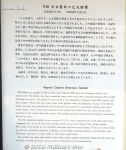
About the Ninomaru Garden
|
|

Ninomaru East Garden
|
|
|

Approximate site of the Aomatsuba Incident near the East Gate. Wjere three chief Tokugawa retainers were executed.
|
|

About the Aomatsuba Incident.
|
|

Way back to East Entrance with a wisteria trellis on the right.
|
|

Nagoya Castle manhole, Aichi.
|
|
|
|